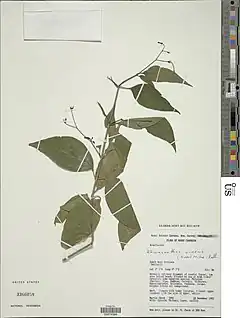Rhinacanthus virens
Rhinacanthus virens (Nees) Milne-Redh. est une espèce de plantes de la famille des Acanthaceae et du genre Rhinacanthus, présente en Afrique tropicale.
Rhinacanthus virens

Rhinacanthus virens récolté en 1996 à Bakingili, au mont Cameroun.
Description
C'est une herbe ou sous-arbuste pouvant atteindre 1,3 m de hauteur[3].
Distribution
L'espèce est présente depuis la Guinée jusqu'en Ouganda et au nord-ouest de la Tanzanie[3].
Notes et références
- The Plant List (2013). Version 1.1. Published on the Internet; http://www.theplantlist.org/, consulté le 11 janvier 2018
- UICN, consulté le 11 janvier 2018
- (en) Martin Cheek, Yvette Harvey, Jean-Michel Onana (dir.), « Rhinacanthus virens (Nees) Milne-Redh. », in The Plants of Mefou Proposed National Park, Central Province, Cameroon: A Conservation Checklist, Kew Publishing, 2010, p. 120 (ISBN 978-1842464007)
Bibliographie
- (en) Martin Cheek, Yvette Harvey, Jean-Michel Onana (dir.), « Rhinacanthus virens (Nees) Milne-Redh. », in The Plants of Mefou Proposed National Park, Central Province, Cameroon: A Conservation Checklist, Kew Publishing, 2010, p. 120 (ISBN 978-1842464007)
- (en) Iain Darbyshire and Timothy Harris, « Notes on the Genus Rhinacanthus (Acanthaceae) in Africa with a Synopsis of the R. nasutus-R. gracilis Complex and a Key to the African Members of the Genus », in Kew Bulletin, Vol. 61, No. 3 (2006), p. 401-418, [lire en ligne]
Liens externes
- (en) Référence Catalogue of Life : Rhinacanthus virens (Nees) Milne-Redh. (consulté le )
- (en) Référence Kew Garden World Checklist : nv (consulté le )
- (en) Référence NCBI : Rhinacanthus virens (taxons inclus) (consulté le )
- (en) Référence The Plant List : Rhinacanthus virens (Nees) Milne-Redh. (source : KewGarden WCSP) (consulté le )
- (en) Référence Tropicos : Rhinacanthus virens (Nees) Milne-Redh. (+ liste sous-taxons) (consulté le )
- (en) Référence UICN : espèce Rhinacanthus virens (Nees) Milne-Redh. (Nees) Milne-Redh. (Syn. de Rhinacanthus virens) (consulté le )
- Spécimens (Muséum national d'histoire naturelle)
- Spécimens (Global Plants, JSTOR)
Cet article est issu de wikipedia. Text licence: CC BY-SA 4.0, Des conditions supplémentaires peuvent s’appliquer aux fichiers multimédias.
